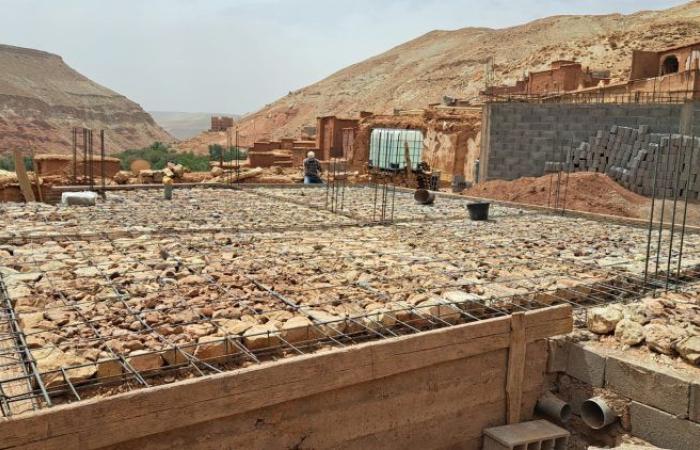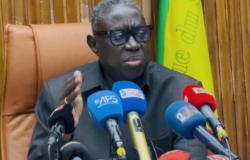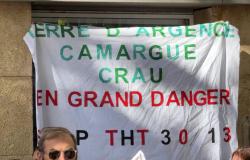By Monceyf Fadili
One year after the 6.9 magnitude earthquake that struck the Marrakech region on September 8, 2023, leaving 3,000 dead, 5,500 injured and tens of thousands homeless, the question arises of the progress of reconstruction, the methods of implementation and the deadlines, in an environment subject to economic and social constraints, which the earthquake has only accentuated.
One of the first initiatives following the earthquake was the royal instruction for the establishment of a relief, assistance and support plan for disaster-stricken populations, and the creation of an interministerial committee responsible for the reconstruction program.
An emergency aid fund of 20,000 DH ($2,050) was released to disaster-stricken families, the first payment for the reconstruction or rehabilitation of housing, supplemented by monthly aid of 2,500 DH ($250) – housing totally or partially destroyed – concerning 64,000 families over 11 months, or 1.760 billion DH.
A reconstruction between physical constraints and implementation processes
The earthquake zone covers an area of 53,135 km2 representing five provinces (Al Haouz, Azilal, Chichaoua Ouarzazate, Taroudant) and one prefecture (Marrakech), for an estimated population of 2,600,000 inhabitants and 578,000 households (High Commission for Planning, HCP – 2023). The predominantly mountainous environment, difficult access and dispersed housing – more than 6,000 douars partially or completely destroyed – were the first constraints encountered by the rescue and clearance teams represented by the army, the gendarmerie and civil protection.
A finding that reveals the scale of the disaster: out of the 244 municipalities in the territory, 169 municipalities are affected (69%). Of this number, 57% concern the provinces of Al Haouz and Taroudant alone, with the municipalities of Al Haouz being completely affected. Clearing destroyed homes, roads and rural tracks was one of the priorities; more than 90% of the time, this operation helped restore the movement of people and the delivery of goods and materials needed for reconstruction.
Read also: Al Haouz: One year after the earthquake, the mobilization for reconstruction does not weaken
Among the main physical constraints encountered are the relief (1,000 to 2,000 m altitude), the uneven roads and a rural track service which accentuates the isolation, the average distance from the housing to the tarmac road being 6 km; 8 km in the province of Azilal, with significant disparities (national average of 3 km).
It should be noted that the construction process was launched in a context of simultaneous start of work, in the presence of a small and poorly qualified workforce, and constraints linked to the transport of construction materials. So many factors which register,de facto the reconstruction process over the long term, if we take into account the necessary technical and administrative assembly stages linked to the assessment of the state of the building, and the fact that the reconstruction in situ
has been adopted by almost all of the disaster-stricken populations.
The main phases of the reconstruction process concern the geotechnical study in a public laboratory, the architectural plan with anti-seismic structure (foundations – posts – beams – slabs), the building permit and the monitoring of the works.
As a reminder, three tranches of payments allocated to reconstruction follow the first tranche of emergency aid, based on the submission of a file to local authorities and monitoring, for a total of 80,000 DH. At the same time, direct financial aid of 140,000 DH is allocated in tranches for completely destroyed housing, i.e. a total of 55,000 building permits filed, for housing that was originally precarious and vulnerable to earthquakes, if we consider that 50% of housing is made of rammed earth or stone – 60% for Al Haouz – and 42% of reinforced concrete, bricks or concrete blocks.
Advanced reconstruction: the case of Telouet
The rural commune of Télouet is located 80 km northwest of Ouarzazate, the provincial capital. With an area of approximately 1,000 km2 and an average altitude of 1,800 m, it is one of the high-altitude and landlocked disaster areas, with almost all of its 45 douars being served by track.
The municipality has 15,000 inhabitants for 2,500 households, or 6 people per household (average of 4.5 for all the disaster areas).
Of the 745 houses demolished, the progress rate of the work varies between 60% and 70%, including the reconstruction and reinforcement of the building. The construction material for the housing is terracotta brick, or concrete block in most cases. A deliberate choice by the residents for reasons of cost and time frame, and taking into account the lack of skilled labor in rammed earth and stone construction techniques, which represent less than 5% of all constructions.
All homes are subject to earthquake-resistant standards.
A necessary coordination and monitoring structure for reconstruction
By September 2024, of the 58,000 families who had received a first payment of 20,000 DH, 36% had received a second payment, 15% a third payment and only 1.6% a fourth payment, or 939 families. A low rate, given the precarious state of families and the number of homeless people who are preparing to face a second winter.
An initial assessment reveals that one year after the earthquake and for the province of Al Haouz alone, where almost all housing was destroyed (23,360), 1,000 housing units have been completed (5%), under the heading of reconstruction and rehabilitation; very few, given the emergency situation and the expected pace of reconstruction. A similar situation of delay is to be noted with regard to the housing conditions of the homeless populations. Out of a total of 27,000 households in the province of Al Haouz – whose housing was partially or completely destroyed –, 8,200 occupy tents (30%) in a situation of under-equipment and in contrasting temperatures, negative in winter, scorching in summer.
These delays in rehousing, which raise the issue of the return of populations to normal life, are part of a vast programme of general reconstruction of the disaster-stricken provinces according to four components: (i) the reconstruction of housing and the rehabilitation of infrastructure; (ii) the opening up and upgrading of territories; (iii) the reduction of social deficits; (iv) the encouragement of economic activity and employment.
On a forecast program of 120 billion DH ($12.3 billion) over five years (2024-2028), the components relating to the reduction of social deficits and the encouragement of economic activity represent 82% of the envelope devoted to the post-earthquake, testifying to the urgency of a vast plan to catch up and upgrade the disaster-stricken provinces, among the poorest in Morocco: the monetary poverty rate in the disaster-stricken areas is 8% for a national average of 4.8%, and more than 20% of the population of Al Haouz lives in a situation of economic vulnerability, double the national average (12.6%).
Indicators which, beyond the urgency of rehousing and the reestablishment of social ties, call into question the dimension of a medium-term development process, the programming and implementation of which must take place within the framework of a structure dedicated to reconstruction, uniting the stakeholders in reconstruction at the institutional, elected and associative levels.
The project for such a structure was imposed in the aftermath of the earthquake through the decree-law establishing the High Atlas Development Agency (Official Bulletin, October 5, 2023), a public establishment whose mission is to supervise the reconstruction and rehabilitation program for disaster-stricken areas, in coordination with all departments and stakeholders concerned.
This establishment, whose roadmap was supposed to be effective after its promulgation, is not operational to date, the reconstruction project being the responsibility of the interministerial committee coordinated by the Head of Government, in particular relayed by the Ministries of the Interior, Equipment and Housing. A definite lack, where a mandated structure, with assigned objectives and missions, would have given full meaning to the political will to register the creation of a public establishment according to an emergency reconstruction approach and a territorial strategic vision.
Such a structure would be able to give real scope to the decentralization process advocated by the 2011 Constitution, and to actively involve the Regions, in accordance with their prerogatives, the affected provinces and prefectures falling under the Regions of Béni Mellal-Khénifra, Drâa-Tafilalet and Marrakech-Safi. The opportunity for a concerted and shared approach in favor of neglected areas, for inclusive and sustainable territorial development.
Monceyf Fadili
International expert in urban planning






